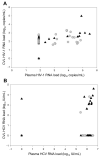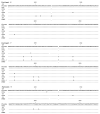Presence of hepatitis C virus (HCV) RNA in the genital tracts of HCV/HIV-1-coinfected women
- PMID: 16206070
- PMCID: PMC3164119
- DOI: 10.1086/491742
Presence of hepatitis C virus (HCV) RNA in the genital tracts of HCV/HIV-1-coinfected women
Abstract
Background: Hepatitis C virus (HCV)-infected women--in particular, those coinfected with human immunodeficiency virus type 1 (HIV-1)--can transmit infection to their children and sex partners.
Methods: The present study was conducted to analyze the presence of HCV RNA in cervicovaginal lavage (CVL) fluid from 71 women (58 HCV/HIV-1-coinfected women and 13 HCV-infected, HIV-1-uninfected women) enrolled in the Women's Interagency HIV Study.
Results: HCV RNA was detected (by a commercial polymerase chain reaction assay) in CVL fluid from 18 (29%) of the HIV-1-infected women and from none of the HIV-1-uninfected women (P<.05). Multivariate analysis revealed that risk factors for the presence of HCV RNA in CVL fluid were HCV viremia (odds ratio [OR], 16.81; P=.02) and HIV-1 RNA in CVL fluid (OR, 19.87; P=.02). This observation suggests local interactions between HIV-1 and HCV in the genital tract compartment. There was no correlation between HCV RNA in CVL fluid and CD4, CD8, or CD3 cell counts, HIV-1 RNA viremia, the number of leukocytes in CVL fluid, or HIV-1 therapy. Furthermore, in 3 of 5 analyzed patients who had a detectable CVL HCV RNA load, we found viral variants differing in the 5' untranslated region that were present neither in plasma nor in peripheral-blood mononuclear cells.
Conclusions: Our observations point to the importance of the genital tract compartment, in which local HCV replication could be facilitated by local HIV-1 replication.
Figures



Similar articles
-
Possible compartmentalization of hepatitis C viral replication in the genital tract of HIV-1-coinfected women.J Infect Dis. 2006 Dec 1;194(11):1529-36. doi: 10.1086/508889. Epub 2006 Oct 19. J Infect Dis. 2006. PMID: 17083037
-
Association of plasma viremia with HIV-1 RNA levels in cervicovaginal lavage secretions in HIV-1 seropositive ART naïve women from Pune, India.J Clin Virol. 2013 Dec;58(4):730-2. doi: 10.1016/j.jcv.2013.10.018. Epub 2013 Oct 25. J Clin Virol. 2013. PMID: 24238888
-
Association between paired plasma and cervicovaginal lavage fluid HIV-1 RNA levels during 36 months.J Acquir Immune Defic Syndr. 2006 Aug 15;42(5):584-7. doi: 10.1097/01.qai.0000229997.52246.95. J Acquir Immune Defic Syndr. 2006. PMID: 16837866
-
Quantification of hepatitis C virus RNA in peripheral blood mononuclear cells: a comparison between patients chronically infected by HCV and patients coinfected by HIV.Res Virol. 1996 Nov-Dec;147(6):325-32. doi: 10.1016/s0923-2516(97)85124-2. Res Virol. 1996. PMID: 8958585
-
Early HIV-1 target cells in human vaginal and ectocervical mucosa.Am J Reprod Immunol. 2011 Mar;65(3):261-7. doi: 10.1111/j.1600-0897.2010.00939.x. Epub 2010 Dec 1. Am J Reprod Immunol. 2011. PMID: 21118402 Free PMC article. Review.
Cited by
-
Rapid screening for co-infection of HIV and HCV in pregnant women in Benin City, Edo State, Nigeria.Afr Health Sci. 2009 Sep;9(3):137-42. Afr Health Sci. 2009. PMID: 20589140 Free PMC article.
-
A preliminary analysis of hepatitis C virus in pancreatic islet cells.Virol J. 2017 Dec 20;14(1):237. doi: 10.1186/s12985-017-0905-3. Virol J. 2017. PMID: 29258547 Free PMC article.
-
Seroprevalence of hepatitis B, hepatitis C, human immunodeficiency virus, Treponema pallidum, and co-infections among blood donors in Kyrgyzstan: a retrospective analysis (2013-2015).Infect Dis Poverty. 2017 Feb 21;6(1):45. doi: 10.1186/s40249-017-0255-9. Infect Dis Poverty. 2017. PMID: 28222792 Free PMC article.
-
The vaginal eukaryotic DNA virome and preterm birth.Am J Obstet Gynecol. 2018 Aug;219(2):189.e1-189.e12. doi: 10.1016/j.ajog.2018.04.048. Epub 2018 May 5. Am J Obstet Gynecol. 2018. PMID: 29738749 Free PMC article.
-
Trouble with bleeding: risk factors for acute hepatitis C among HIV-positive gay men from Germany--a case-control study.PLoS One. 2011 Mar 8;6(3):e17781. doi: 10.1371/journal.pone.0017781. PLoS One. 2011. PMID: 21408083 Free PMC article.
References
-
- Eyster ME, Diamondstone LS, Lien JM, Ehmann WC, Quan S, Goedert JJ. Natural history of hepatitis C virus infection in multitransfused hemophiliacs: effect of coinfection with human immunodeficiency virus. The Multicenter Hemophilia Cohort Study. J Acquir Immune Defic Syndr. 1993;6:602–10. - PubMed
-
- Garcia-Samaniego J, Soriano V, Castilla J, et al. Influence of hepatitis C virus genotypes and HIV infection on histological severity of chronic hepatitis C. The Hepatitis/HIV Spanish Study Group. Am J Gastroenterol. 1997;92:1130–4. - PubMed
-
- Greub G, Ledergerber B, Battegay M, et al. Clinical progression, survival, and immune recovery during antiretroviral therapy in patients with HIV-1 and hepatitis C virus coinfection: the Swiss HIV Cohort Study. Lancet. 2000;356:1800–5. - PubMed
-
- Piroth L, Duong M, Quantin C, et al. Does hepatitis C virus co-infection accelerate clinical and immunological evolution of HIV-infected patients? AIDS. 1998;12:381–8. - PubMed
-
- Alter H. Discovery of non-A, non-B hepatitis and identification of its etiology. Am J Med. 1999;107(Suppl):S16–20. - PubMed
Publication types
MeSH terms
Substances
Grants and funding
- M01 RR000079/RR/NCRR NIH HHS/United States
- U01-AI-42590/AI/NIAID NIH HHS/United States
- U01 AI035004/AI/NIAID NIH HHS/United States
- U01-HD-32632/HD/NICHD NIH HHS/United States
- U01-AI-35004/AI/NIAID NIH HHS/United States
- U01-AI-31834/AI/NIAID NIH HHS/United States
- U01-AI-34993/AI/NIAID NIH HHS/United States
- U01 AI034993/AI/NIAID NIH HHS/United States
- M01-RR00083/RR/NCRR NIH HHS/United States
- U01 AI031834/AI/NIAID NIH HHS/United States
- R56 AI052065/AI/NIAID NIH HHS/United States
- M01-RR00079/RR/NCRR NIH HHS/United States
- U01 AI034989/AI/NIAID NIH HHS/United States
- R01 AI052065/AI/NIAID NIH HHS/United States
- U01-AI-34994/AI/NIAID NIH HHS/United States
- DA13760/DA/NIDA NIH HHS/United States
- U01 AI034994/AI/NIAID NIH HHS/United States
- R01 A13760-01/PHS HHS/United States
- M01 RR000083/RR/NCRR NIH HHS/United States
- R01AI52065-01/AI/NIAID NIH HHS/United States
- U01-AI-34989/AI/NIAID NIH HHS/United States
- U01 HD032632/HD/NICHD NIH HHS/United States
- U01 AI042590/AI/NIAID NIH HHS/United States
LinkOut - more resources
Full Text Sources
Medical
Research Materials

